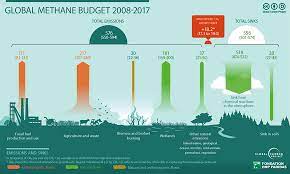
by Bill Schlesinger
In recent months, there has been a lot of attention devoted to methane emission as a contribution to the gases in the atmosphere that cause global warming. Methane concentrations were relatively constant in the atmosphere until the beginning of the Industrial Revolution. It is easy to point a finger at the oil and gas industry as the source of rising methane in the atmosphere in recent years.
Unfortunately, it is not so simple. About half of the estimated emissions of methane to the atmosphere each year come from natural sources, especially wetlands and leakage from the Earth’s crust. Before the Industrial Revolution, these emissions, totaling almost 400 million metric tons/year, must have been balanced by an equal number of “sinks” that removed methane from the atmosphere, keeping the concentration relatively constant.
No matter how large the natural sources are, it is new sources of methane that must account for the increasing its concentrations in the atmosphere. Apparently, new emissions overwhelm processes that destroy methane, so the remainder stays in the atmosphere.
New sources of methane include emissions from the production and transport of fossil fuels, from cattle, from waste management, and from forest fires. Various advocacy groups have focused on fossil fuel emissions, and recently huge emissions from petroleum facilities have been measured using satellites. Emissions of methane from fossil fuels, largely natural gas, are also consistent with the recent rise in ethane in the atmosphere—a gas that is coproduced with natural gas.
On the other hand, changes in the isotopic composition of methane in the atmosphere are more consistent with the recent source of emissions being from wetlands. Humans have destroyed many wetlands during the last century, but an increasing new flux from wetlands may be associated with warming at northern latitudes, where waterlogged soils, bogs, and permafrost are now all subject to greater microbial activity and the generation of methane. Methane emissions from northern latitudes contributed strongly to the rise in methane concentrations in the atmosphere at the end of the last continental glaciation.
I’ve blogged in the past about the methane emissions from cattle, suggesting that if we ate less beef, smaller herds of cattle would be needed, reducing their contribution to methane in the atmosphere. (See: https://blogs.nicholas.duke.
My point here is not to exonerate the oil and gas industry, or to divert our attention from their large emissions of methane to the atmosphere. These emissions are probably the easiest to cap. But, the rising concentration of methane in the atmosphere may stem from a multitude of sources, and we should tackle all those we can if we are to bring the Earth’s methane cycle back in balance.
References:
Helmig, D. and others. 2016. Reversal of global atmospheric ethane and propane trends large due to US oil and natural gas production. Nature Geoscience 9(7): 490-495.
Lauvaux, T. and 7 others. 2022. Global assessment of oil and gas methane ultra-emitters. Science 375: 557-561.
Schlesinger, W.H. and E.S. Bernhardt. 2020. Biogeochemistry: An analysis of global change. 4th ed. Academic Press/Elsevier, San Diego